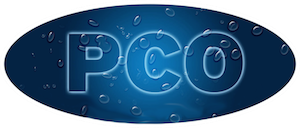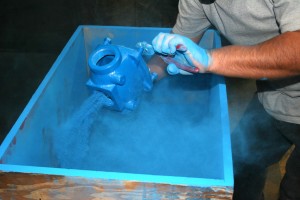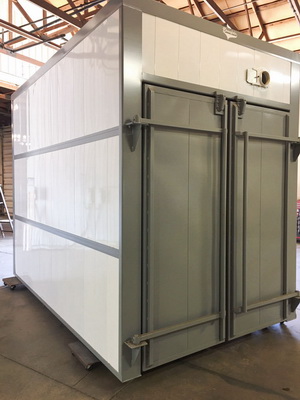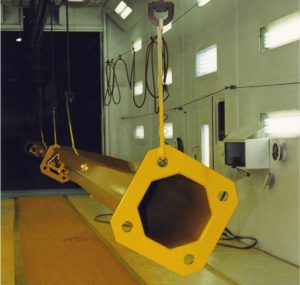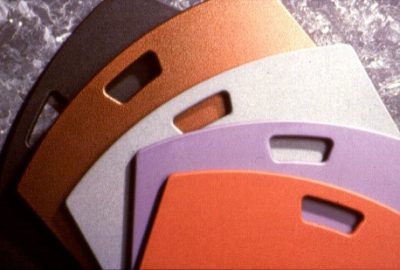A fluidized bed is an open box with a “plenum” chamber underneath, separated by a porous membrane. Air is introduced into the lower chamber, which then passes into the upper box uniformly. The density of free flowing powder in the upper box is reduced by the air, such that 24 inch deep powder in a “dead” bed rises to 28 or 30 inches deep. In a properly moving fluid bed you can reach your hand all the way down the bottom of the box. Depending on the powder in the bed, there may be a substantial amount of dusting coming out of the box. Powders designed for fluid bed application generally have 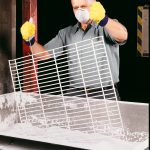 larger particle size than the “thin film” eletrostatic powders, and are ideally spherical in shape to allow easy free flow properties.
larger particle size than the “thin film” eletrostatic powders, and are ideally spherical in shape to allow easy free flow properties.
The two main uses of a fluid bed are 1) for coating large irregular items such as dish washer baskets or pipe fittings. The part is pre-heated at a higher temperature than the melting point of the powder (since the powder ‘quenches’ or cools the part right away) then dipped into the fluid bed and moved around under the surface. The retained heat in the part and the time immersed in the fluidizing powder determines the thickness of the coating. When the part is pulled out, there may be immediate melting of the coating, or it may have a “sugar coating” on the surface. Usually the part is then post-heated, ideally in another oven at a lower temperature, perhaps at or just above the melt point of the powder. Too high of a temperature will cause the coating to sag or even drip. The post heat is simply to flow out the coating, since most powders used with this method are “thermoplastic” (needing to melt only for property development, and able to re-melt if it sees heat again) as opposed to “thermoset” (cross-linking and chemically changed after the cure cycle, and will not re-melt). Common materials used for this method are Vinyl (PVC), Nylon, and Polyethylene, and in some cases thick-film epoxies (which do need a cure).
The other use for a fluid bed 2) is with an electrostatic gun. The powder is put into the upper box, compressed air is supplied to the lower box and adjusted so the powder just moves without dusting too much. In this case the top of the fluidizing box is closed to contain the dusting, with some sort of filtered vent. The powder is then drawn up to the gun when the trigger is pressed. This is generally a superior method for preparing the powder for the spray gun compared to the “vibrating table, auger feed” method, where an aerated suction hose is dropped into the open box of powder and the powder is drawn up to the gun. The suction is easier in application of high volumes of powder, since the coater just has to set up the box once until it is empty. With the fluidizer, the powder is scooped or poured into the upper box as needed. With conventional homogenous powders, there is probably no difference in application, but with some “complex” powders such as Veins, Metallics, and some of Polychem’s unique compound mixes, the fluid bed technique assures a uniform application. The suction feed method does not allow for any settling or striation variations which the box may have developed in transit or use.
Fluid beds may be purchased from electrostatic gun manufacturers for an arm and a leg. Most Vinyl powder coaters ( less common anymore, since there have been health related questions raised in using Vinyl) used to make their own fluidizers. The walls of the bed can be made from sealed wood or coated sheet metal, then flanged to the lower chamber. Fluid beds range from a few inches on a side to several feet on a side. I know of one coater who would dip sixteen foot long light poles into a fluid bed filled with Nylon.
As I understand it, the clever State of California has declared that each fluid bed is an air pollution source (whether filled or not, whether in use or not) and several coaters have limited their inventory since each unit has a license fee.
David R. Collander
PolyChem Industries, Inc.
Find suppliers of fluidized beds and hoppers on PowderCoatingOnline.com.
Related Resources
- Building Environment Enclosures
- Engineered Buildings
- Powder Coaters Corner
- Powder Coating Industry Research
- Contact
Fluidized Beds for Powder Coating
